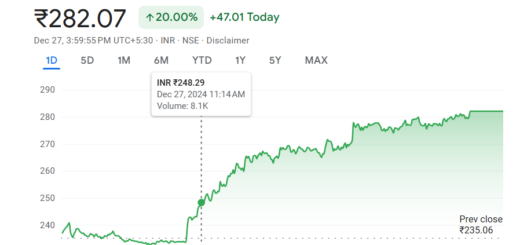The 6 Stories of successful small businesses in India
The small businesses Entrepreneurship is a risky yet potentially rewarding endeavor. According to insights from Entrepreneurship Essentials, 50% of startups last five years, while only 25% survive beyond 15 years. This disparity underlines the importance of strategic planning and execution in building a sustainable business.

As Harvard Business School professor William Sahlman aptly states, “For every Amazon.com or Uber, there are dozens of companies that few people remember.” The critical question then becomes: What differentiates successful ventures from those that fail?
The answer lies in identifying the right opportunities, making strategic decisions, and consistently delivering value to customers. This article explores inspiring stories of successful small businesses in India that have overcome challenges, carved their niche, and made a mark in their respective industries.
1. Lijjat Papad: From a Modest Beginning to a Household Name
Lijjat Papad started in 1959 as a small cooperative of seven women in Mumbai with a capital of just ₹80. Their mission was simple: to produce high-quality papads (Indian lentil crackers) and earn a livelihood. The idea took off because of their focus on quality and consistent taste.
What made Lijjat Papad a success was its cooperative model, where each woman was both an employee and a co-owner of the business. Today, the Shri Mahila Griha Udyog Lijjat Papad has over 45,000 women members and generates annual revenues exceeding ₹1,600 crore.
The key lessons from Lijjat Papad are the power of a simple idea, the value of quality assurance, and the impact of empowering local communities.
2. Chumbak: From Souvenirs to a Lifestyle Brand
Chumbak started in 2010 as a quirky souvenir brand aimed at Indian travelers looking for colorful, India-themed keepsakes. Founded by Shubhra Chadda and Vivek Prabhakar, the business quickly expanded beyond magnets and souvenirs to become a full-fledged lifestyle brand.
What set Chumbak apart was its unique design language that blended contemporary aesthetics with Indian motifs. As e-commerce boomed in India, Chumbak leveraged online marketplaces and social media to reach a broader audience.
Today, Chumbak is synonymous with quirky home décor, fashion, and accessories. Its success highlights the importance of branding, design innovation, and adaptability in a competitive market.
3. Paper Boat: Nostalgia in a Bottle
Paper Boat, founded by Neeraj Kakkar and James Nuttall, entered the beverage market in 2013 with a unique proposition: to revive traditional Indian drinks like Aam Panna, Jaljeera, and Kokum. The brand’s ethos revolved around evoking nostalgia for simpler times.
What set Paper Boat apart was its innovative packaging, emotional storytelling, and focus on natural ingredients. By positioning itself as a premium yet relatable brand, Paper Boat created a loyal customer base.
The brand’s success underscores the importance of storytelling in marketing, understanding consumer emotions, and staying authentic to your roots.
4. Amul: The Taste of India
While Amul is no longer a “small business,” its origins as a cooperative dairy initiative in 1946 make it one of the most inspiring success stories in India. Amul’s model empowered rural farmers by providing them fair prices for their milk and created a value chain that has since become a benchmark for the dairy industry worldwide.
The “Amul Girl” advertising campaign, with its witty takes on current events, also played a pivotal role in making Amul a beloved brand. Today, Amul represents the power of cooperative entrepreneurship and grassroots innovation.
5. Wow! Momo: A Fast-Food Revolution
Started in 2008 by two college friends, Sagar Daryani and Binod Homagai, Wow! Momo has redefined fast food in India. The idea was simple yet effective: to create a brand entirely focused on momos, a popular street food.
Wow! Momo’s success lies in its ability to innovate while staying true to its core product. From chocolate momos to momo burgers, the brand kept its menu fresh and exciting. It also leveraged aggressive expansion strategies, opening outlets in malls, airports, and tech parks across the country.
Today, Wow! Momo is a ₹500 crore brand, showing that with the right focus, even a single-product concept can scale successfully.
6. Zivame: Revolutionizing Women’s Lingerie Shopping
Richa Kar founded Zivame in 2011 to solve a problem that many Indian women faced: the lack of comfortable and private lingerie shopping experiences. The online platform broke societal taboos and empowered women to make informed choices about their intimate wear.
Zivame’s success is attributed to its user-friendly interface, diverse product range, and discreet packaging. The brand also invested heavily in educating customers about lingerie fit and style, creating a loyal customer base.
This story highlights the importance of addressing customer pain points and challenging societal norms to create a meaningful business.
Common Threads in Success Stories of small businesses
While each of these businesses operates in different industries, there are several common themes that emerge from their success stories:
- Understanding the Customer: Successful businesses prioritize understanding their target audience’s needs, preferences, and pain points. For example, Lijjat Papad focused on quality, while Zivame created a safe shopping space for women.
- Innovation and Adaptability: Brands like Chumbak and Wow! Momo succeeded because they were willing to experiment and adapt to changing market trends.
- Storytelling and Branding: Companies like Paper Boat and Amul leveraged storytelling to connect emotionally with their audience. A strong brand narrative builds trust and loyalty.
- Community and Empowerment: Businesses like Amul and Lijjat Papad showcased the power of community-driven entrepreneurship, where collective efforts create sustainable success.
- Consistency and Quality: No matter how innovative a business is, consistency in quality is non-negotiable. Brands like Chumbak and Wow! Momo ensure they deliver on their promises to customers.
Final Thoughts
India’s small business landscape is as diverse as its culture. From cooperatives like Amul and Lijjat Papad to modern startups like Paper Boat and Zivame, these success stories inspire entrepreneurs to dream big and stay resilient.
While the path of entrepreneurship is fraught with challenges, these businesses prove that with the right idea, strategic execution, and unwavering determination, it is possible to create lasting value for customers and communities.
As you embark on your entrepreneurial journey, remember to learn from these stories, avoid common pitfalls, and remain adaptable to change. The next great Indian success story could be yours!
FAQ’s small business.
The success of businesses like Lijjat Papad and Amul can be attributed to their cooperative model, which empowers local communities and ensures fair pricing. They focus on quality and leverage the collective efforts of their members to build sustainable and scalable operations.
Chumbak stood out by blending contemporary aesthetics with Indian motifs, creating a unique design language. The brand leveraged e-commerce and social media effectively, which helped it expand its reach and establish itself as a go-to lifestyle brand for quirky, India-inspired products.
Wow! Momo innovated by diversifying its menu with unique momo variants like chocolate momos and momo burgers, keeping customers intrigued. Paper Boat focused on reviving traditional Indian beverages with a modern twist, creating nostalgia-driven branding and innovative packaging that appealed to a wide audience.
Zivame addressed a significant gap in the market by creating a comfortable and private online shopping platform for lingerie. It educated customers on proper fit and style, offered discreet packaging, and challenged societal taboos, making lingerie shopping more accessible and empowering for women.
Deep understanding of their target audience’s needs and preferences.
Willingness to innovate and adapt to market changes.
Strong storytelling and branding to connect emotionally with customers.
Consistency in quality and delivery of promised value.
Community-driven models or empowerment strategies, as seen in Amul and Lijjat Papad.
Aspiring entrepreneurs can learn the importance of understanding customer pain points, staying authentic to their brand’s values, and consistently delivering quality. Strategic adaptability, effective storytelling, and leveraging local resources or community support can also play a crucial role in building a successful business.




